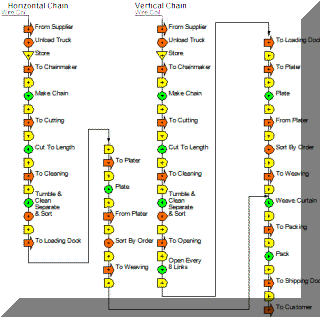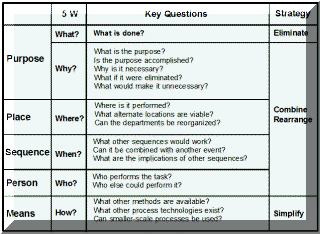The Future State Process Chart
Brainstorming & Questioning
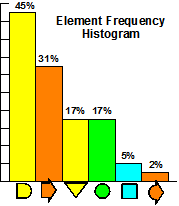 Present State Map
Present State Map
The "Present State" process chart or map shows the "real" process as it presently exists. The real process is what actually happens on the factory floor. This may differ significantly from the process specifications or official routings.
Measuring the Results
Once complete, the team can measure results in several ways. The simplest is to count the symbols and construct a frequency percent histogram as shown.
Processes that have not been studied and refined generally show 5%-15% added value. Future state processes typically show 15%-25% added value and eliminate half of the wasteful events.
This is a crude but effective metric. Elapsed time, labor hours or cost might also be used.
Ideal State Map

An "Ideal State Map" is useful and easy to construct. An ideal process has no waste so we simply take the "Current State" map and eliminate non-value adding events, as shown.
Real processes seldom approach this ideal state. However, the ideal state map helps us to focus on the value added events. It provides a benchmark.
See "A Mental Model" for another view of this ideal process.
Future State Map
With current and ideal state maps, a team has a deep and common knowledge of the process. Their next task is to identify improvements and illustrate them with a "Future State" map.
A future state map bridges the gulf between the current and ideal states. It incorporates the realities of technical limits, budgets and time.
Developing a future state map is often surprisingly easy. Often, they identify problems and find solutions with only informal discussion.
The primary tools are Brainstorming and what Alan Mogensen (Work Simplification pioneer) called "The Questioning Attitude."
Process Improvement Example
Ideal State
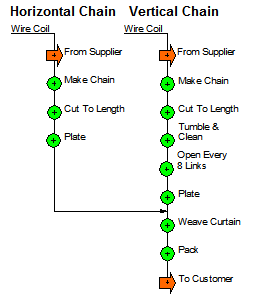
Practical Future State
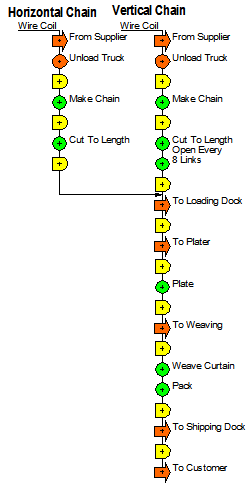

Detective Columbo
"There are a couple of loose ends I'd like to tie up. Nothing important you understand."
Columbo Approach
Detective Columbo always scratched his head and asked a lot of questions. A good mapping facilitator does the same. Below is a formal list of questions that could be applied to every element.
Good facilitators often suspect where the critical issues lie and direct questions accordingly. Alan Mogensen, the originator of "Work Simplification", called this "the questioning attitude."
Key Questions
The table below has a list of questions that, in theory, a team can and should ask of every element in the process.
The first two columns identify the type of characteristic such as purpose or place that the question will clarify. The next column relates the characteristic with the classic 5W's. The final column indicates the most common strategies for improvement.
Rudyard Kipling, who was a news reporter before being a poet, immortalized the 5 W's in his story "the Elephant's Child." Kipling knew the value of questioning and reasoning but he also knew the value of intuition and quieting the mind. Thus, the last stanza below.
Brainstorming
 Group
brainstorming uses the experience and creativity of all members. When individual members reach
their limit, another member can take the idea to the next stage.
Group
brainstorming uses the experience and creativity of all members. When individual members reach
their limit, another member can take the idea to the next stage.
But, brainstorming in a group can be psychologically risky for individuals. Valuable but strange suggestions may appear stupid at first. The facilitator ensures that others do not crush ideas.
Participants should come from a wide range of disciplines. This brings broad experience and increases creativity. Appoint one person to note ideas on a flip chart. Study and evaluate after the session.
Facilitation Techniques
►Define the problem clearly and identify any criteria to be met.
►Stay focused on the problem
►Ensure that no one criticizes or evaluates ideas during the session.
►Encourage an enthusiastic, uncritical attitude in the group. Try to get everyone to contribute, including the quiet members
►Let people have fun.
►Encourage people to raise as many ideas as possible, from solidly practical to wildly impractical.
►Welcome creativity.
►Ensure that no train of thought is followed for too long
►Encourage people to expand other's ideas; use other ideas to create new ones
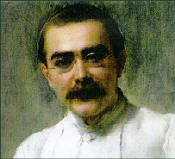
Rudyard Kipling
I KEEP six honest serving-men
(They taught me all I knew);
Their names are What and Why and When
And How and Where and Who.
I send them over land and sea,
I send them east and west;
But after they have worked for me, I give them all a rest.
■ ■ ■ ■ ■ ■ ■

